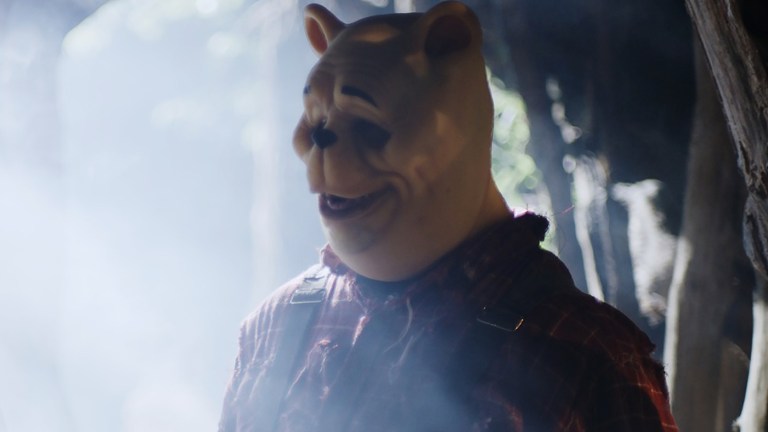Why Winnie the Pooh Slasher Movie Legally Cannot Look Like the Pooh Bear You Know
Winnie-the-Pooh: Blood and Honey realized its destiny as social media fodder with a new trailer… but there’s a legal reason you can barely recognize the movie’s killer Pooh Bear.

Winnie the Pooh, Winnie the Pooh, willy, silly, old bear is coming for you! One imagines that the filmmakers behind Winnie-the-Pooh: Blood and Honey would absolutely love to include lyrics like those above in their new Winnie the Pooh slasher movie. It’d be as if Disneyland’s Main Street intersected with Freddy Kreuger’s Elm! However, for much of the same reason that “Winnie-the-Pooh” is nigh unrecognizable in the Blood and Honey trailer, there’s a reason you’ll never hear the above riff on the iconic Pooh Bear song in the new movie: the filmmakers behind Blood and Honey legally aren’t allowed to use it.
Indeed, the below Winnie-the-Pooh: Blood and Honey trailer hit the internet like a ton of bricks Wednesday morning when it revealed relatively modest (and formulaic) scares going down in the Hundred Acre Wood, with Winnie and his pal Piglet hunting and seemingly butchering Christopher Robin (Nikolai Leon) with axes. It’s the kind of grotesque imagery that Disney executives have dreaded for decades: a beloved piece of pop culture Americana (and Walt Disney intellectual property) entering the public domain and being transformed into horror shock and veritable schlock.
Still, there’s something off about the film, and not just because it features a grown man in a cheap mask pretending he’s a bear. When you squint for a moment, you’ll also notice it doesn’t really feature any of the Winnie the Pooh iconography you’re familiar with. In fact, even the title seems wrong with its over-hyphenated emphasis on “Winnie-the-Pooh.”
The reason for this is that Blood and Honey still does not have the public domain rights to many of the Pooh Bear elements your child memories were built on—including that famous “Winnie the Pooh” song written by the Sherman Brothers of Mary Poppins and Chitty Chitty Bang Bang fame. Disney does.
Admittedly, it was a victory for those precious few who still believe that fiction should be in the hands of the public—as opposed to an ever shrinking collection of media conglomerates—when A.A. Milne’s Winnie-the-Pooh entered the public domain on Jan. 1, 2022. That book, which was first published in 1926, introduced the world to Pooh, Piglet, Eeyore, Owl, Rabbit, and the other members of the Hundred Acre gang. However, as a literary creation, that collection of stories was also limited (or liberated) by a child’s imagination. There were illustrations, of course, by artist E.H. Shepard, however the text presented a gentle, pastoral image intended to set children’s mind aflutter. It would be years before there was any merchandise created to cash-in and shape those same kids’ mental image of Pooh.
Our modern conception of the character didn’t really exist until at least 1932. That was the year American businessman Stephen Slesinger introduced the world to drawings (and later toys) of Winnie-the-Pooh in a red shirt and without pants. Before then, the character had always been illustrated with no human clothes at all. Slesinger was able to create this look because two years earlier, Milne sold the merchandising rights of Winnie-the-Pooh to Slesinger, effectively creating the modern licensing industry. And after his death, Slesinger’s widow continued the trend when she licensed those same rights to Walt Disney Productions in 1961.
Hence the first of Disney’s near countless Winnie the Pooh films and cartoons: the 1966 short film “Winnie the Pooh and the Honey Tree.” Incidentally, this was the first creative project where Disney dropped the hyphens in Winnie the Pooh’s name, as well as where the Sherman Brothers’ “Winnie the Pooh” song was introduced to millions of children around the world.
As of 2022, a red-shirted and pants-less Winnie the Pooh, as well as the song and countless other aspects to the character’s pop culture iconography, remain copyrighted by Disney and Milne’s descendants. One imagines so does the tenor of Pooh’s voice, which, ever since Sterling Holloway voiced the character in ’66, has had an unmistakably distinct cadence.
Hence why we hear no “does Christopher Robin have some honey?” in the new Winnie-the-Pooh: Blood and Honey trailer. It’s more than likely also the reason writer-director Rhys Waterfield and his producers felt it prudent to maintain Milne’s original hyphenated “Winnie-the-Pooh” name for their title (although if you look at the poster, they try to minimize that too).
With that said, one wonders if Disney is looking awfully hard at that red plaid shirt that “Pooh Bear” is bathing in blood…
